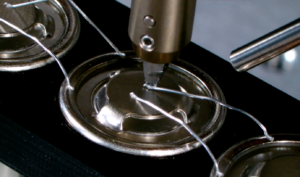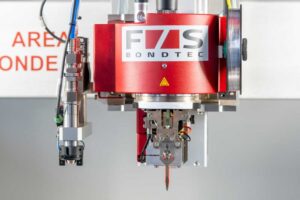The recycling of used battery modules
The recycling of used battery modules is of great economic interest and is also promoted and required at the political level by the EU. It involves a considerable volume: according to a study by Fraunhofer ISI, around 230,000 tons of used lithium batteries will be incurred annually in Europe alone from 2030, and around 1,500,000 tons from 2040.
Universal production unit 86XX for battery modules
At the moment, the recycling of batteries is being discussed at the level of the materials they contain, so the batteries are being scrapped. It would largely be possible to reuse entire cells, because often in defective battery modules, only a few cells are actually faulty.
New modules could be put together from the remaining cells. However, this usually fails because the cells cannot easily be separated from the module assembly. The contacts cannot be detached without damaging the cell, at least for the most widespread resistance- or laser-welded connections.
The solution to this problem are wire bond connections, as used in many batteries for e-vehicles: they are in-bulk connections, i.e. robust and durable, but at the same time they do not contain a melting phase and thus are without structural changes. It is therefore possible to contact a battery cell a second time using a wire bond.
SERIES 86
Our SERIES 86 universal production unit, combines several functions for the re-manufacturing of battery modules in a single machine. As a wire bonder, SERIES 86 creates conventional connections of the modules in the initial production. In re-manufacturing, it covers further manufacturing steps:
1. First, the old wire bonds are gently removed. A shear test head, which is normally intended for quality control of heavy wire bonds, is used for this purpose. The wire bond is pushed away to the side by a shear chisel and the force required for this is measured; this is a measure of the quality of the bond.
The same process can be used perfectly to gently remove the bond (Fig. 1). Both, the point of attack on the bond and the height above the substrate are precisely determined by the shear test head and readjusted with a pattern recognition system so that the bond can be removed without damaging the surface. The whole process is fully automatic and therefore highly productive, because the wire bonds of an entire module are removed without operator support.
In addition, if desired, the shear test function can be used to measure the quality of the removed bonds, e.g. to record the aging status of the battery module with regard to the connections

Fig. 1 – Bonding wire is removed with a shear tool.
2. In the second step, the state of each individual cell can be determined. A quick-change measuring head on the machine is used for this purpose, which again automatically contacts each cell with a measuring probe (with programmable contact force and other adjustable parameters) and carries out the desired electrical measurements. Comparison tables with empirical values for battery cells from different manufacturers are already available in order to classify the quality of the cells in question. This allows not only a good/bad assessment, but also a finer sorting of the cells into different quality classes for further re-use.
3. In the third step, which takes place outside the machine, the cells are removed from the module and, if necessary, sorted according to quality class. The cells can then be put together to form new modules.
4. The fourth and possibly fifth step is done again by Series 86: the cells are again interconnected with the wire bond head to form a module.
5. If a visual inspection or the measurement of the connection quality in step 1 shows that the surface quality of the bond areas is no longer good, a cleaning unit can be installed on the bond head (Fig. 2) which cleans and activates the surfaces with CO2 dry snow before they are contacted by the wire bonder. This step is also fully automated and programmed.

Fig. 2 – Bond head with additional CO2 cleaning unit
The Series 86 has a large work area to accommodate battery modules up to 51 x 72 cm in size, or several small modules next to each other. It can also be equipped with automated part change, if the production volumes require it. We see the area of application primarily for high-mix/low-volume battery modules, for example for newcomers to the industry. Here in particular, the desire to re-manufacture used modules is particularly pronounced.
That is why we have developed a cost-effective machine that is also attractive for newcomers and that is easy to use despite its wide range of functions. This is mainly due to the extremely flexible software, which can incorporate new and additional functions without great effort. In this way, the production cell can also be expanded in terms of hardware and software in the future, e.g. with a further refined optical inspection or a dispensing function for adhesives or seals.

